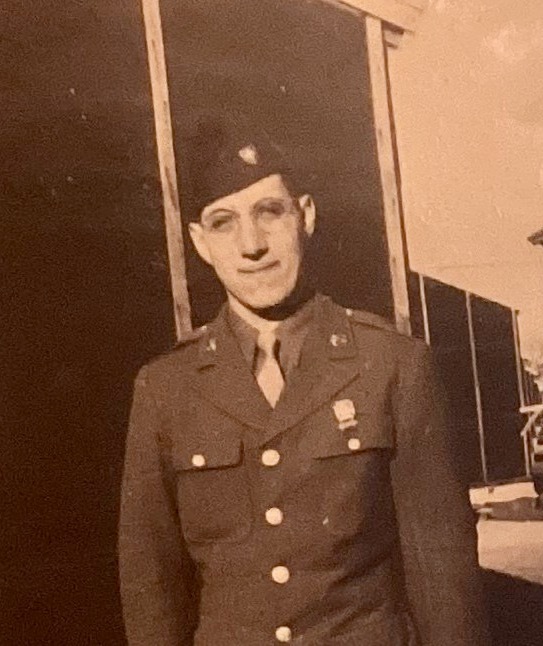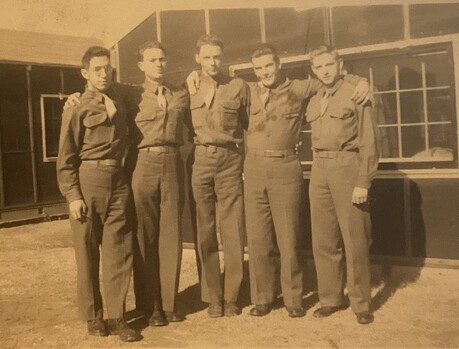Arthur Samuel Pruzan

PFC in Signal Co, Special
Military occupational specialty: 776 (radio operator, low speed)
ASN#42138163
Born 1926 in NY, Died 1990
County of residence at enlistment: Bronx County, NY
Other residence(s): Bronx, NY; Tarrytown, NY
United States Army, European Theatre of Operations
Occupation before the war: Student
College education before the war: CCNY 2 years
College education after the war: Cantor Lipitz Cantorial Institute; Columbia School of Social Work
Arthur Pruzan was born on April 5, 1926 in the Bronx, one of only eight Ghost Army veterans to be born after 1925. He was an only child; his father, a house painter, had been born in Latvia and his mother in Poland.
Arthur showed an early talent as a singer, and was featured as a boy soloist leading traditional Hebrew choral groups. He also studied theory and singing at several New York city schools. He had a bout of rheumatic fever as a child which caused some heart damage, but he managed to run track in both high school and college. In 1942 he graduated from DeWitt Clinton High School, a boys' public high school in the Bronx, and went on to study at the City College of New York (CCNY).

Arthur Pruzan on the far left; courtesy of Elliot Pruzan
He registered for the draft on his 18th birthday, April 5, 1944, and enlisted at the end of his sophomore year of college, on June 26, 1944. The Army trained him in radio communications and radio mechanics, and he was eventually assigned to the Signal Company Special. He served overseas with the unit in May and June, 1945, as a low speed radio operator, returning with the unit to the US on June 23, 1945.
A newspaper article from 1951 says that he served as an assistant chaplain while he was in the Army, and his discharge papers describe his role as a military policeman; it is not clear whether he filled these roles before, during, or after his time with the Ghost Army.
After his discharge from the Army on May 23, 1946 with the rank of PFC, he returned to New York and used his GI Bill benefits to go back to school. He graduated from the Cantor Lipitz Cantorial Institute in 1948, and likely also from CCNY at about the same time. He also married Anne Mandel in 1948, on January 29. He and Anne would go on to have three children: Mark, Elliot, and Rochelle.
Arthur and his family lived on Allerton Avenue in the Bronx, next door to the Allerton Coops, which was the most storied of the large cooperative developments built in the late 1920s in the Bronx by working class Jewish New York City residents. The original population of the Coops, which occupied two city blocks, was largely composed of Yiddish-speaking Communists in the garment industry, and offered a socialist community housing option with communal kitchens, gardens, and kindergartens. Arthur's son, Elliot Pruzan, says that "my father was not a Coop Commie, but there were no right wingers where we lived."
After completing his education, he immediately found work as a cantor in several New York City congregations. A 1951 newspaper article reported that he had "appeared in a number of concerts and has received numerous press notices suggesting the quality of his art and the scope of his abilities." He made at least one 78 record as a cantorial singer. He was selected to lead the High Holy Day services for Rosh Hashanah and Yom Kippur at the Miriam Barnert Free School and Temple in Paterson, NJ in 1951.
Unfortunately, his planned life's work as a cantor ended abruptly when he contracted polio sometime in 1953-1954. While he was luckier than many of polio's victims, he suffered throat damage which put an end to his singing career.
And so he found other employment. First, leveraging his musical training, he went to work as a salesman at Sam Goody's Music. Then he became a linotypist with the New York Times, where he worked from 1958-1968 and was an active member of the newspaper's typographical union. (The union went on strike and shut down newspapers in the mid-60s, a big deal in New York City!) Arthur had a lifetime commitment to social justice, honed by his immigrant parents, his experience as a chaplain and his exposure to the Holocaust in World War II, his major illnesses as a child and young man, his Bronx neighborhood, his work as a cantor, and his membership in the union.
In 1968 he furthered that commitment by taking a job as a social worker with the New York City Bureau of Child Welfare, and going back to school to pursue a graduate degree at Columbia School of Social Work. There he studied with Richard Cloward, who was a leftwing advocate for a guaranteed minimum income. He received his MS in Social Work from Columbia in 1970. After five years with the city, he was hired to be an administrator with the New York Association for New Americans (NYANA), an organization founded in 1949 to resettle Holocaust refugees, and, after 1972, other non-Jewish immigrant groups.
He continued to work in the social welfare field, serving for some years as Assistant Director for the Hebrew Immigrant Aid Society, and later as Executive Director of Holocaust Publications, before returning to the Bureau of Child Welfare where he worked until shortly before his death.
Arthur was also a ballet and opera aficionado, and a Freemason. His son Elliot says that he was "a congenial, friendly, good-natured man. A friend of ours once said he could charm the birds out of the trees!"
He died on May 30, 1990, from heart surgery complications. Elliot says that "my dad was living for a long while on borrowed time. No one knew how ill he really was until the end." Arthur is buried at Beth David Cemetery in Elmont, NY.
*A cantor is a trained vocalist who leads a Jewish congregation in song and prayer.
Sources:
1930 census
1940 census
1944 draft card
1944 enlistment record
1944 WWII hospital admission card files
1948 marriage record
1950-1990 US Public Records Index
1951 article in The Morning Call (Paterson, NJ) about his work as a cantor
https://www.newspapers.com/image/553647338/?terms=arthur%20pruzan&match=1
1974 article in the Jersey Journal (Jersey City, NJ) about his work with NYANA
https://www.newspapers.com/image/911956827/?terms=arthur%20pruzan&match=1
1984 article in the Central New Jersey Home News (New Brunswick, NJ) about his work with Holocaust Publications
https://www.newspapers.com/image/317280418/?terms=pruzan&match=1
1990 Social Security applications and claims index
2023 (October 19) GALP Veteran Biography Worksheet from son Elliot Pruzan